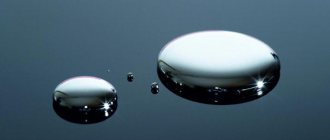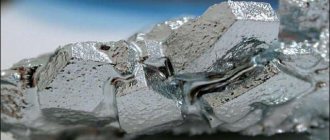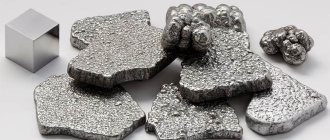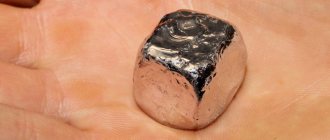Most of the heaviest metals are rare and extremely valuable. Many achievements of modern technology and medicine would simply be impossible if they did not exist.
Most of these metals are not widely used in everyday life (at best, platinum and gold come to mind here). Therefore, the significance of many of them for civilization can only be assessed by specialists. At the same time, the history of the discovery of some is interesting in itself.
We present to you a ranking of the world's densest metals.
Tantalum - 16.67 g/cm³
Extremely refractory (melting point 3017 °C), tantalum successfully replaces platinum in many cases.
It is used in jewelry - watch cases, bracelets and other jewelry are made from it. This is facilitated by the high hardness of the metal. In addition, it is cheaper than platinum, although more expensive than silver.
Its compounds replace platinum as catalysts in the chemical industry. In glassmaking, the addition of this metal to the melt makes it possible to obtain glasses used for the production of small binoculars and lightweight glasses. And tantalum is absolutely irreplaceable in the production of radio electronics.
Titanium
The final place in the top ten hardest metals goes to titanium. For the first time this element was obtained in its pure form by the chemist J. Ya. Berzelius from Sweden in 1825. Titanium is a lightweight silver-white metal that is highly durable and resistant to corrosion and mechanical stress. Titanium alloys are used in many branches of mechanical engineering, medicine and the chemical industry.
Titanium
Uranium - 19.05 g/cm³
The name of the planet of the solar system came from the name of this element, and not vice versa, as many believe.
It is a very heavy, flexible and malleable metal. Capable of self-ignition. There is a lot of it both in the earth's crust and in sea water.
Thanks to uranium, invisible rays were accidentally discovered at the end of the 19th century (today the phenomenon of the emission of invisible rays by some natural substances is called radioactivity).
Natural uranium oxides have been used since ancient times in the manufacture of glazes for ceramic products. Nowadays, compounds of this metal are also used to create yellow paint.
Video of the heaviest metals
Humanity began to actively use metals back in 3000-4000 BC. Then people became acquainted with the most common of them: gold, silver, copper. These metals were very easy to find on the surface of the earth. A little later they learned about chemistry and began to isolate such species as tin, lead and iron. In the Middle Ages, very poisonous types of metals gained popularity. There was arsenic in use, which poisoned more than half of the royal court in France. Likewise, which helped cure various diseases of those times, from sore throat to the plague. Already before the twentieth century, more than 60 metals were known, and at the beginning of the 21st century - 90. Progress does not stand still and leads humanity forward. But the question arises, which metal is heavy and weighs more than all the others? And in general, what are they, these heaviest metals in the world?
Many people mistakenly think that gold and lead are the heaviest metals. Why exactly did this happen? Many of us grew up watching old movies and seeing the main character using a lead plate to protect himself from vicious bullets. In addition, lead plates are still used today in some types of body armor. And when you hear the word gold, many people think of a picture of heavy ingots of this metal. But thinking that they are the heaviest is a mistake!
To determine the heaviest metal, one must take into account its density, because the higher the density of a substance, the heavier it is.
Tungsten - 19.29 g/cm³
Absolute champion in refractoriness. It boils at a temperature of 5555 °C (the same in the photosphere of the Sun).
The word tungsten means “devouring tin like a wolf devouring a sheep.” This name did not appear by chance. Tungsten, being among the tin ores, interfered with the smelting of tin.
Used to create wedding rings. Its strength symbolizes the stability of personal relationships. In addition, polished tungsten cannot be scratched by anything.
It is used in the production of filaments in various lighting devices.
Gold - 19.29 g/cm³
The gold content in the ground is very low, although there are many deposits rich in it. There is even a little gold in water - in every cubic meter there is at least five micrograms of gold.
Under normal conditions, it does not oxidize and does not interact with most acids, therefore it is considered a noble metal.
Gold easily transmits heat and electricity, making it indispensable in radio electronics.
Plutonium - 19.80 g/cm³
The first artificial chemical element, whose production began on an industrial scale almost immediately after its discovery.
Named after Pluto, which was “demoted” in 2006, deprived of its planetary status.
Interest in plutonium was initially driven by its military applications. High density and abnormally high compressibility made it possible to produce compact, powerful and structurally simple atomic charges.
All isotopes of plutonium are radioactive. The “reactor” isotope of plutonium makes it possible to create long-lived maintenance-free (up to a hundred years of operation) energy sources.
How do you find the value?
The density of metals is a characteristic that can be determined in two fundamentally different ways:
- experimental;
- theoretical.
Experimental methods are of the following types:
- Direct measurements of body weight and volume. The latter is easy to calculate if the geometric parameters of the body are known and its shape is ideal, for example, a prism, pyramid or ball.
- Hydrostatic measurements. In this case, special scales are used, invented by Galileo in the 16th century. The principle of their operation is quite simple: first, a body of unknown density is weighed in air, and then in liquid (water). After this, the required value is calculated using a simple formula.
As for the theoretical method of determining the density of metals, this is a fairly simple method that requires knowledge of the type of crystal lattice, the interatomic distance in it and the mass of the atom. Next, using the example of osmium, we will show how this method is used.
Neptunium - 20.47 g/cm³
It was obtained artificially from uranium through nuclear reactions. It is interesting that it was named not in honor of the ancient Greek deity Neptune, but indirectly - due to its practical invisibility in nature in honor of the planet Neptune, which itself was named in honor of the deity, but for a long time was not amenable to observation by astronomers.
This metal has no independent value, but in the radiochemical industry it is a “step” from uranium to the production of the next important radiomaterial - plutonium.
Osmium and iridium are the heaviest metals in the world
Let's look at the main heavyweights who share 1st and 2nd places. Let's start with iridium and at the same time say words of gratitude to the English scientist Smithson Tennat, who in 1803 obtained this chemical element from platinum, where it was present along with osmium as an impurity. Iridium can be translated from ancient Greek as “rainbow”. The metal is white with a silver tint and can be called not only the heaviest, but also the most durable. There is very little of it on our planet and only up to 10,000 kg are mined per year. It is known that most iridium deposits can be found at meteorite impact sites. Some scientists come to the conclusion that this metal was previously widespread on our planet, but due to its weight, it constantly squeezed itself closer to the center of the Earth. Iridium is now widely in demand in industry and is used to generate electrical energy. Paleontologists also like to use it, and with the help of iridium they determine the age of many finds. In addition, this metal can be used to coat some surfaces. But this is difficult to do.
Next, let's look at osmium. It is the heaviest in the periodic table of Mendeleev, and, accordingly, the heaviest metal in the world. Osmium is tin-white with a blue tint and was also discovered by Smithson Tennat at the same time as iridium. Osmium is almost impossible to process and is mainly found at meteorite impact sites. It smells unpleasant, the smell is like a mixture of chlorine and garlic. And from ancient Greek it is translated as “smell”. The metal is quite refractory and is used in light bulbs and other devices with refractory metals. For just one gram of this element you have to pay more than $10,000, which makes it clear that the metal is very rare.
The use of metals in everyday life began at the dawn of human development, and the first metal was copper, since it is available in nature and can be easily processed. It is not without reason that archaeologists during excavations find various products and household utensils made of this metal. In the process of evolution, people gradually learned to combine various metals, obtaining increasingly durable alloys suitable for making tools, and later weapons. Nowadays, experiments continue, thanks to which it is possible to identify the strongest metals in the world.
Rhenium - 21.01 g/cm³
Named after the Rhine River, the site of its discovery.
Very rare, the only economically viable rhenium deposit is located in Russia.
Refractoriness, chemical neutrality and good ductility allow this metal to be used to create medical instruments.
Heat-resistant alloys of rhenium with other metals are used in the production of jet engines. Thus, rhenium is of great military and strategic importance.
Electrical conductivity:
All metals conduct electricity , due to the presence in their crystal lattices of mobile electrons that move under the influence of an electric field.
Silver, copper and aluminum have the highest electrical conductivity. For this reason, the last two metals are most often used as wire materials. Sodium also has very high electrical conductivity. In experimental equipment, attempts are known to use sodium conductors in the form of thin-walled stainless steel pipes filled with sodium. Due to the low specific gravity of sodium, with equal resistance, sodium “wires” are much lighter than copper and even somewhat lighter than aluminum.
Platinum - 21.40 g/cm³
The name platinum was invented by the conquistadors. Literally from Spanish it means “silver”. This disparaging name is explained by the special refractoriness of the metal. For many years they did not know how to use it; then platinum cost half as much as silver.
Nowadays it is valued much more than even gold. Extreme refractoriness, chemical inertness and excellent properties as a catalyst for chemical reactions make it indispensable in industry. At the same time, high cost and good strength open up ways for use in jewelry.
Osmium: discovery, features, application
Osmium is also the heaviest metal on the periodic table. The tin-white metal with a blue tint was discovered by Smithson Tennat a year after the discovery of iridium in platinum. When platinum was dissolved in aqua regia, the scientist discovered this element in the sediment, which is a rather rarely used and expensive metal, but at the same time incredibly useful.
Osmium, like the previous identified metal, is almost impossible to process. It is mostly found in meteorites, but large deposits can also be found on our planet (for example, they exist in Russia, the USA and South Africa). A distinctive feature of osmium is its unpleasant odor, in which you can smell both garlic and chlorine. Therefore, from ancient Greek the name “osmium” means “smell”.
As a rule, osmium is used to make incandescent light bulbs or other devices that require the use of refractory materials. Can be used as a catalyst in the ammonia production process. The high strength of osmium allows it to be used for the manufacture of surgical instruments. To determine the real age of an iron meteorite, the isotope osmium 187 is used. Kazakhstan can “boast” of a natural deposit of osmium. But for a gram of such metal mined from this deposit, the buyer will have to pay at least $10,000, and all because this metal is quite rare.
It can be noted that this is some kind of incredible coincidence that such heavy and rare metals are found in one alloy. And in order to separate these materials, making them separate metals that can be used in various industries, you will have to devote a lot of effort and time to the process.
Incredible facts
When it comes to jewelry, many of us dream of a dazzling pearl or diamonds, depending on the size of our wallet. In most cases, the chain or setting that holds the jewelry itself plays second fiddle.
However, there is a reason why your neighbor hides gold coins and your father locks the family silver in a safe. Gold and silver are extremely valuable materials due to their rarity, high socio-economic value, non-reactivity, ability to resist corrosion and oxidative forces. From year to year, even from month to month, prices for these metals fluctuate significantly.
However, among other things, these valuable metals are also used for industrial purposes. For example, platinum group metals are used in laboratory equipment, dental materials, and electronics. Precious and valuable metals also serve as an investment vehicle. It is important to note that the conventional unit of weight for precious metals is the troy ounce, which is equal to 1.1 standard ounces or 0.031 kg.
Let's take a look at the most valuable metals in the world and understand what makes them so special.
10. Indium
If precious metals had a personality, indium would probably be a whiny baby. It is very soft (literally and figuratively), has an indigo color inside (named after its spectral line is that color), and makes a sort of "scream" when bent.
Indium is a rare metal that is extracted from zinc, lead, iron and copper ores. In its pure form, indium is a white metal that is extremely malleable and very shiny. It was first widely used during World War II as bearings on aircraft engines. Indium is also used to create corrosion-resistant mirrors, semiconductors, alloys, and electrical conductivity in a variety of devices.
In 2009, the average price for indium was $500 per kilogram (15 per troy ounce), with China, South Korea and Japan considered its largest producers. With rising prices for indium, its processing and further disposal is becoming increasingly popular.
9. Silver
Silver is one of the most valuable metals on earth. This brilliant white metal in its pure form is the finest electrical and thermal conductor, yet has the lowest resistance.
You probably know the main uses of silver - jewelry, coins, photography, various circuits, dentistry, batteries. In more unusual applications, silver can be used to prevent the spread of bacteria on the surface of a mobile phone, remove unpleasant odors from shoes, and prevent mold from growing on treated wood.
Silver is often used in alloys with copper, gold and lead-zinc ores. The largest producers of silver are Peru, China, Mexico and Chile. The average price of silver is $432 per kilogram (13.40 per troy ounce), although prices are rising regularly. Due to its many uses, silver is considered one of the most valuable metals in the world.
8. Rhenium
Although perhaps not as well known as gold and platinum, rhenium silver is one of the densest metals and has the third highest melting point.
Because of its similar properties, rhenium, discovered in 1925, is used in high-temperature gas turbine engines. This metal is also added to nickel heat-resistant alloys to improve resistance to high temperatures. Other applications include thermocouples, electrical materials, etc.
Rhenium is a byproduct of molybdenum, which is essentially a byproduct of copper mining. Chile, Kazakhstan and the USA top the list of countries mining this valuable metal. Prices vary widely, with the latest jump from $2,419 per kilogram to $4,548.
7. Palladium
In 1803, William Hyde Wollaston found a way to separate palladium from the surrounding platinum ores. This grayish-white precious metal is prized for its rarity, ductility, resistance to high temperatures, and its ability to absorb large amounts of hydrogen at room temperature.
Palladium, named after the Greek goddess Pallas, is one of the members of the group of precious metals. Its valuable properties are in high demand, so it is used in a variety of industries: car manufacturers rely on it to make catalytic converters that control emissions; jewelers use it to create white gold alloys; Electronics manufacturers use it to coat their devices because palladium has good conductive properties.
Although palladium prices have risen recently, the average price is $8,483 per kilogram (263 per troy ounce). Almost half of the palladium is produced in Russia, followed by South Africa, the USA, Canada and other countries.
6. Osmium
Osmium is one of the densest elements on earth, it is bluish-silver in color and was discovered in 1803 by Smithson Tennant. He also discovered iridium (#5 on our list). The debate about which of these metals is heavier (osmium or iridium) has not yet been resolved.
Rarely found, osmium is usually found in ores of other platinum group metals and is mined in some regions of Russia and North and South America. The average price for it is $12,700 per kilogram.
This very hard metal has an extremely high melting point, making it difficult to handle. Osmium is primarily used to strengthen platinum alloys in electrical contacts, fibers, and other applications. It is worth noting that there are dangers associated with processing osmium, as it releases toxic oxides that can irritate the skin and damage the eyes.
5. Iridium
This metal is by far the most extreme member of the platinum group. It is white in color, has a surprisingly high melting point, is one of the densest elements and the most corrosion resistant metal. Water, air, acids have no real effect on iridium.
Due to its similar properties, it is extremely difficult to extract and even more difficult to process. Most of it comes from South Africa, it is extracted from platinum ores and acts as a by-product of nickel mining. Its average price per kilogram is $13,548. Its unique features allow this hard metal to contribute to advances in the fields of medicine, electronics, and automotive. Even jewelers are trying to use iridium in some of their exclusive creations.
4. Ruthenium
Ruthenium, a bright gray metal, was discovered in 1844 by Russian scientist Karl Karlovich Klaus. This member of the platinum group retains many of the characteristics of its peers, including hardness, rarity, and resistance to the elements. At the same time, ruthenium melts at a temperature of 800 degrees Celsius.
Ruthenium is found in similar platinum group ores in the regions of Russia, North and South America, and Canada. Prices for this metal vary, with an average price of $13,548 per kilogram (420 per troy ounce).
After a complex chemical processing process, the metal can be isolated and used for a variety of purposes. It is added to an alloy of platinum and palladium to increase hardness (in jewelry) and for better resistance (with aggressive components, especially titanium). Ruthenium has also become quite popular in the field of electronics as a way to improve the efficiency of electrical contacts.
3. Gold
Gold has always been a coveted commodity, luring everyone from the Egyptians who used it to decorate ancient coffins to the 19th-century gold miners who scoured every corner of the California coast for nuggets.
Due to its universal desirability, strength and ductility, gold remains one of the most popular metals for investment. The average gold price in 2009 was $30,645 per kilogram (950 per ounce), but in just one year the price jumped to $40,290.
The largest gold mines are located in South Africa, the USA, Australia and China. Typically, gold is separated from the surrounding rocks and minerals by panning, after which it is ready for various chemical reactions and smelting.
Besides its use in jewelry, it is also used in industry. Due to its conductivity, it often becomes part of various electrical appliances, and its reflective surface allows it to be used in radiation shields and in the production of office windows.
2. Platinum
The average price for this dazzling silver metal is $38,290 per kilogram. Mined primarily in South Africa, Russia and Canada, platinum has made a name for itself due to its flexibility, density and non-corrosive properties. In addition, like palladium, platinum can absorb large amounts of hydrogen.
This valuable metal has become widely used in the jewelry industry for its lustrous appearance and good resistance. Platinum is also used in areas such as dentistry, aeronautics and weapons production.
1. Rhodium
Rhodium is one of the most valuable metals in the world. This shiny, silver-colored metal has remarkable reflective properties, which is why it is used in headlights, mirrors, and jewelry finishing.
In addition, rhodium is very valuable in the automotive industry. However, due to its high melting point and ability to resist corrosion, rhodium is an important element in other industries. This extremely rare and valuable metal is only mined in certain regions. About 60 percent of rhodium comes from South Africa, followed by Russia. Although the price of this metal has been declining over the years, it is still the most expensive valuable metal currently in existence, with an average price of $46,516 per kilogram.
Currently, 126 chemical elements are already known. But the heaviest among them are considered to be Osmium (Os) and Iridium (Ir). Both of these elements are transition metals and belong to the platinum group. Their serial numbers in the Periodic System of I.P. Mendeleev 76 and 77 respectively. Being very hard, both metals can be compared in density. This is due to the fact that the density values were derived purely theoretically (22.562 g/cm³ (Ir) and 22.587 g/cm³ (Os)). And with such calculations there is always an error (± 0.009 g/cm³ for both calculations).
History of discovery
The discovery of these elements is associated with the name of the English scientist S. Tennant. In 1803 he studied the properties of platinum. And when this metal reacted with a mixture of acids (“aqua regia”), an insoluble precipitate consisting of impurities was isolated. While studying this substance, S. Tennant isolated new elements, which he named “iridium” and “osmium”. The element received the name “iridium” (“rainbow”) because its salts came in a variety of colors. And “osmium” (“smell”) was so named due to the sharp smell of osmium oxide OsO4, close to ozone.
Properties
Both osmium and iridium are practically unprocessable. They have a very high melting point. In compact form, they do not react with active media such as acids, alkalis or mixtures of acids. These properties are observed in osmium at temperatures up to 100°C, and in iridium at temperatures up to 400°C.
Spreading
The most commonly mined form of these elements is iridium osmide. This alloy is mainly found in natural platinum and gold mining areas. Another place where iridium and osmium are often found is in iron meteorites. Osmium without iridium is practically never found in nature. Whereas iridium is found in combinations with other metals. For example, in compounds with ruthenium or rhodium. However, iridium remains one of the most uncommon chemical elements on our planet. Its industrial production in the world does not exceed 3 tons per year. At the moment, the regions that are the main sources of iridium and osmium production are California, Alaska (USA), Siberia (Russia), Bushveld (South Africa), Australia, New Guinea, Canada.










